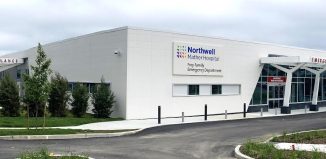Lawrence Aviation site plan hinging on agreement between DOT, MTA

By Mallie Jane Kim
A redevelopment plan for the Lawrence Aviation Superfund site in Port Jefferson Station is at risk due to a proposed rail yard intersecting a straight strip of property owned by the New York Department of Transportation, where the Setauket-Port Jefferson Station Greenway trail runs, according to Suffolk County Planning Commissioner Sarah Lansdale.
Lansdale, speaking at a Three Village Civic Association meeting on June 3, reviewed the existing plan to transform the former aviation factory into three parcels: a 5-megawatt solar array, space for a rail yard that the MTA will own and protected open space that is earmarked for the Town of Brookhaven.
“We’re in contract with all three parcels right now,” Lansdale said, adding that contract terms require an agreement between DOT and MTA by the end of June. “In order to get to closing, there are conditions that need to be met.”
DOT would need to agree to divert a small section of the Greenway path to make way for the planned rail yard, which would help accommodate future modernization of the Port Jefferson Branch of the Long Island Rail Road. However, this change would interrupt DOT’s solid straight line of property, which they reserve in case the need for a highway arises in the future.
“From what I understand, that would serve as a bypass for Route 25A should sea level rise or climate change impact the navigability of 25A,” Lansdale explained.
The Greenway is not currently protected parkland, though Suffolk County Legislator Steve Englebright (D-Setauket) spoke up at the meeting to announce that he had been working with state Assemblyman Fred Thiele (D-Sag Harbor) to fast-track last minute legislation designating the Greenway as parkland.
“The session has the potential to resolve this question,” Englebright said, though as of press time, no related bills had been yet introduced and the 2024 legislative session in Albany is scheduled to end June 6.
Civic association leaders expressed frustration at DOT even considering the possibility of tearing up the Greenway sometime in the future.
“They shouldn’t be going down that road — that’s insulting to our community,” said Herb Mones, who also heads the Three Village Community Trust which oversees the nonprofit that maintains the trail.
Mones added that the DOT had always been a vital partner in building and maintaining the Greenway. “It would be very disappointing if the DOT as an agency isn’t the most cooperative, most helpful in making sure the future of the Greenway continues without nonsense talk of putting in a highway,” he said.
The Lawrence Aviation plan has been in the works since 2022, though discussions between officials and concerned community members about what to do with the site have been going on much longer.
The New York State Department of Environmental Conservation has already led the demolition of buildings on the site, according to Lansdale, who added that the DEC also completed an environmental investigation to remove the site from the Superfund list, which will clear the way for the solar development.
Lansdale expressed hope that the contract requirements will be ironed out on time, as she said the plan has had the benefit of community involvement and support.
“This is a federal Superfund site,” she explained. “The way that these sites are usually sold is on the auction block, with zero community input, to the highest bidder.”
Advocating for modern train technology
Though the Lawrence Aviation site plan reserves space for a rail yard, the MTA has given no indication it has imminent plans to modernize the Port Jefferson Branch of the LIRR, according to clean-train-energy advocate Bruce Miller, who said he has been talking with MTA officials and keeping tabs on the agency’s plans.
At the civic meeting, Miller urged local civic associations to lobby Gov. Kathy Hochul (D) to force the MTA to follow state environmental laws by looking into new train technologies to replace the diesel trains running along Long Island’s North Shore.
“It would be very helpful to be somewhere on the [MTA’s] 20-year plan,” said Miller, who indicated one of his catchphrases when dealing with a New York City-focused MTA is, “We pay taxes, too.”
Miller, who favors hydrogen-powered or separate-car battery trains, said he’d like to get civic leaders and elected officials from both sides of the political aisle to put their heads together and figure out how to get the MTA to explore cleaner train technologies.
Englebright agreed with Miller’s assessment that the MTA is essentially a “rogue agency” not following state directives toward cleaner energy, and suggested lawsuits as a good way to rein it in. He pointed to both the 2021 state constitutional amendment that gives residents the right to clean air and water, and the State Environmental Quality Review Act as bases for lawsuits from the community to force the MTA to look into newer, cleaner trains.
“There should be a lawsuit considered by the civic community to challenge whether the actions or inactions of the MTA and the LIRR are consistent with the Constitution of the State of New York,” Englebright said, adding, “No agency of the state is immune to SEQRA.”
Civic association board member George Hoffman, who said he had listened to LIRR President Rob Free speak earlier in the year, expressed frustration that North Shore trains seem to be an afterthought with the MTA.
“We want to get a solution for the Port Jefferson line,” Hoffman said. “I don’t know if it’s electric, I don’t know if it’s hydrogen — we certainly know it shouldn’t be diesel, it’s one of the dirtiest forms of air pollution.”
Hoffman praised Miller for his leadership on the issue and indicated the civic association hoped to support his advocacy efforts. “The squeaky wheel gets the grease,” he said






